The Impact of Leadership Styles on Organizational Performance at Tesco
VerifiedAdded on 2022/08/18
|57
|12808
|16
Report
AI Summary
This report investigates the impact of various leadership styles, including transactional, democratic, and transformational leadership, on the organizational performance of Tesco. The research employs an interpretivist philosophy and an inductive approach, utilizing a mixed research design that combines qualitative and quantitative data collection methods. Both primary and secondary data are gathered, with statistical analysis employed to interpret the findings. The report explores the relationship between different leadership styles and Tesco's performance, addressing leadership challenges and recommending effective strategies. The study includes a literature review, detailed methodology, data analysis, and findings, culminating in conclusions and recommendations for improving organizational performance. The report also considers ethical considerations throughout the research process, and includes survey results through questionnaires and charts.
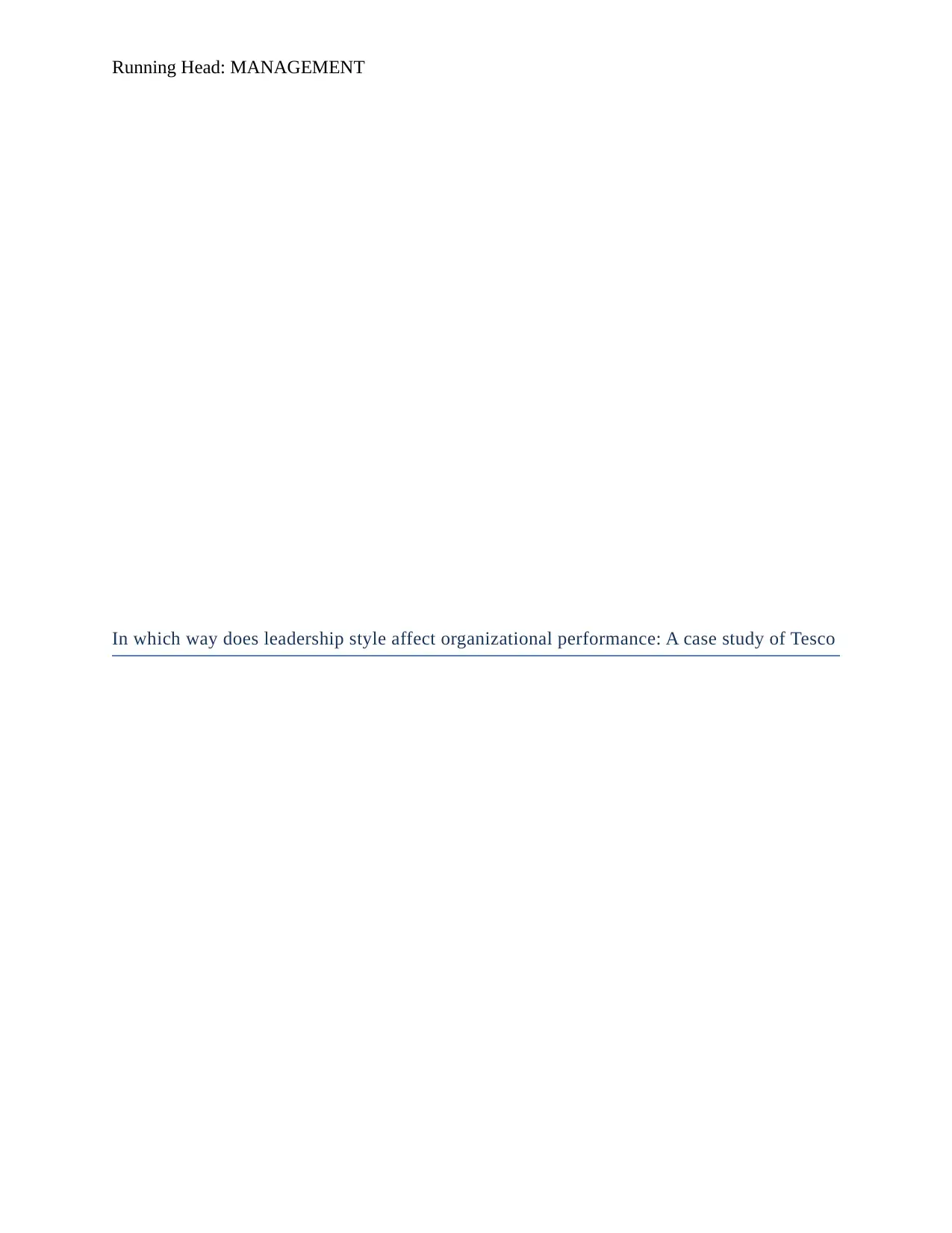
Running Head: MANAGEMENT
In which way does leadership style affect organizational performance: A case study of Tesco
In which way does leadership style affect organizational performance: A case study of Tesco
Paraphrase This Document
Need a fresh take? Get an instant paraphrase of this document with our AI Paraphraser
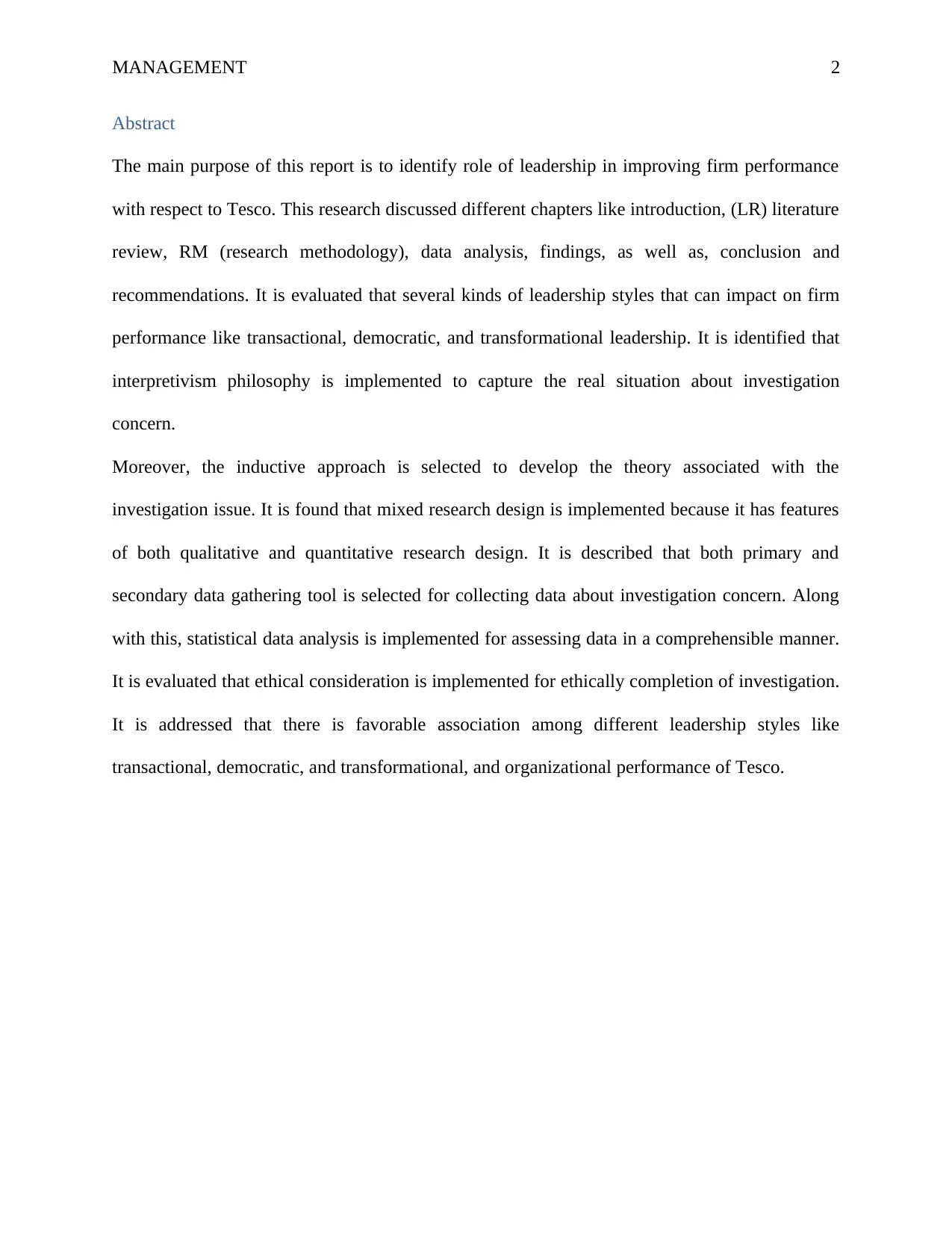
MANAGEMENT 2
Abstract
The main purpose of this report is to identify role of leadership in improving firm performance
with respect to Tesco. This research discussed different chapters like introduction, (LR) literature
review, RM (research methodology), data analysis, findings, as well as, conclusion and
recommendations. It is evaluated that several kinds of leadership styles that can impact on firm
performance like transactional, democratic, and transformational leadership. It is identified that
interpretivism philosophy is implemented to capture the real situation about investigation
concern.
Moreover, the inductive approach is selected to develop the theory associated with the
investigation issue. It is found that mixed research design is implemented because it has features
of both qualitative and quantitative research design. It is described that both primary and
secondary data gathering tool is selected for collecting data about investigation concern. Along
with this, statistical data analysis is implemented for assessing data in a comprehensible manner.
It is evaluated that ethical consideration is implemented for ethically completion of investigation.
It is addressed that there is favorable association among different leadership styles like
transactional, democratic, and transformational, and organizational performance of Tesco.
Abstract
The main purpose of this report is to identify role of leadership in improving firm performance
with respect to Tesco. This research discussed different chapters like introduction, (LR) literature
review, RM (research methodology), data analysis, findings, as well as, conclusion and
recommendations. It is evaluated that several kinds of leadership styles that can impact on firm
performance like transactional, democratic, and transformational leadership. It is identified that
interpretivism philosophy is implemented to capture the real situation about investigation
concern.
Moreover, the inductive approach is selected to develop the theory associated with the
investigation issue. It is found that mixed research design is implemented because it has features
of both qualitative and quantitative research design. It is described that both primary and
secondary data gathering tool is selected for collecting data about investigation concern. Along
with this, statistical data analysis is implemented for assessing data in a comprehensible manner.
It is evaluated that ethical consideration is implemented for ethically completion of investigation.
It is addressed that there is favorable association among different leadership styles like
transactional, democratic, and transformational, and organizational performance of Tesco.
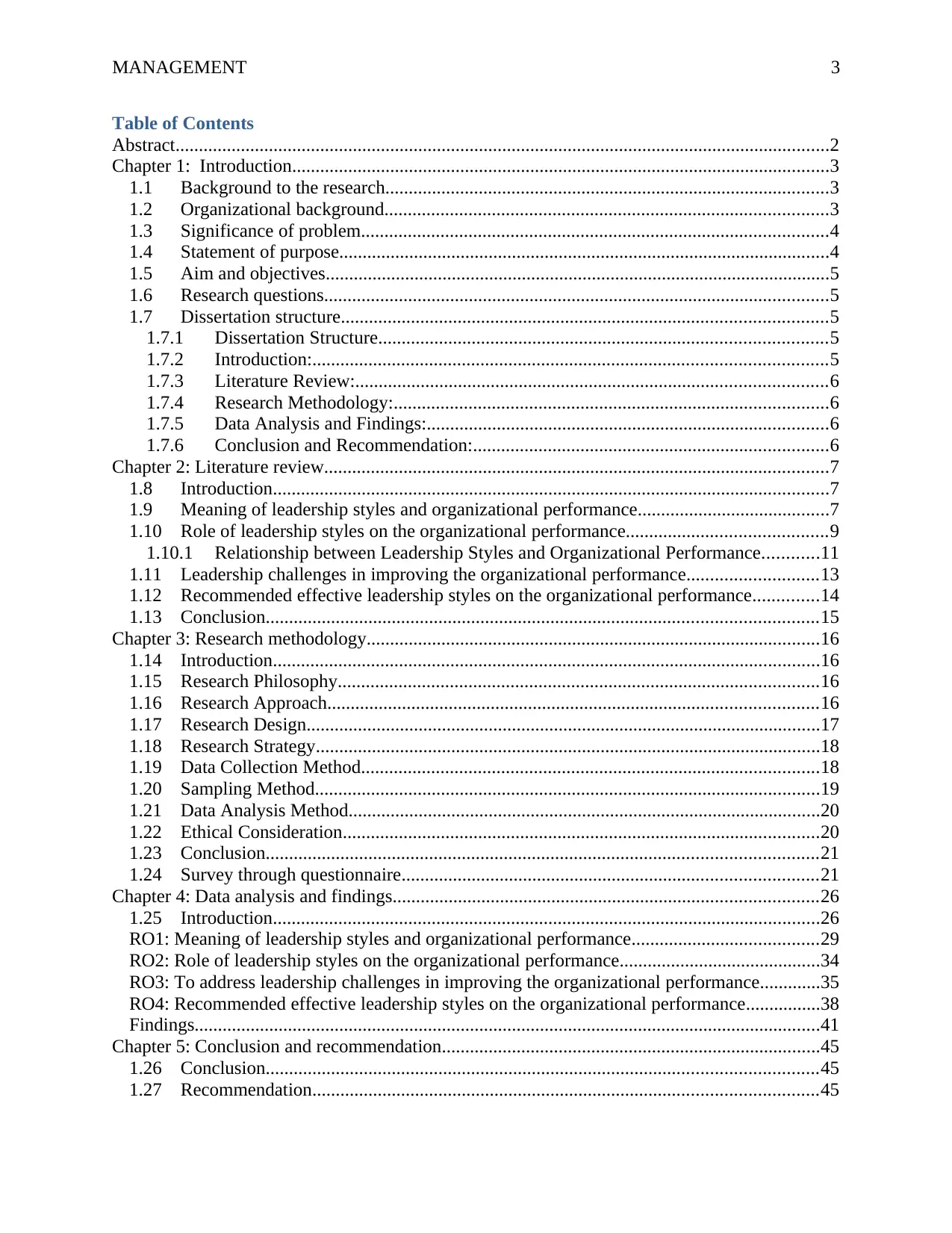
MANAGEMENT 3
Table of Contents
Abstract............................................................................................................................................2
Chapter 1: Introduction...................................................................................................................3
1.1 Background to the research...............................................................................................3
1.2 Organizational background...............................................................................................3
1.3 Significance of problem....................................................................................................4
1.4 Statement of purpose.........................................................................................................4
1.5 Aim and objectives............................................................................................................5
1.6 Research questions............................................................................................................5
1.7 Dissertation structure........................................................................................................5
1.7.1 Dissertation Structure................................................................................................5
1.7.2 Introduction:..............................................................................................................5
1.7.3 Literature Review:.....................................................................................................6
1.7.4 Research Methodology:.............................................................................................6
1.7.5 Data Analysis and Findings:......................................................................................6
1.7.6 Conclusion and Recommendation:............................................................................6
Chapter 2: Literature review............................................................................................................7
1.8 Introduction.......................................................................................................................7
1.9 Meaning of leadership styles and organizational performance.........................................7
1.10 Role of leadership styles on the organizational performance...........................................9
1.10.1 Relationship between Leadership Styles and Organizational Performance............11
1.11 Leadership challenges in improving the organizational performance............................13
1.12 Recommended effective leadership styles on the organizational performance..............14
1.13 Conclusion......................................................................................................................15
Chapter 3: Research methodology.................................................................................................16
1.14 Introduction.....................................................................................................................16
1.15 Research Philosophy.......................................................................................................16
1.16 Research Approach.........................................................................................................16
1.17 Research Design..............................................................................................................17
1.18 Research Strategy............................................................................................................18
1.19 Data Collection Method..................................................................................................18
1.20 Sampling Method............................................................................................................19
1.21 Data Analysis Method.....................................................................................................20
1.22 Ethical Consideration......................................................................................................20
1.23 Conclusion......................................................................................................................21
1.24 Survey through questionnaire.........................................................................................21
Chapter 4: Data analysis and findings...........................................................................................26
1.25 Introduction.....................................................................................................................26
RO1: Meaning of leadership styles and organizational performance........................................29
RO2: Role of leadership styles on the organizational performance...........................................34
RO3: To address leadership challenges in improving the organizational performance.............35
RO4: Recommended effective leadership styles on the organizational performance................38
Findings......................................................................................................................................41
Chapter 5: Conclusion and recommendation.................................................................................45
1.26 Conclusion......................................................................................................................45
1.27 Recommendation............................................................................................................45
Table of Contents
Abstract............................................................................................................................................2
Chapter 1: Introduction...................................................................................................................3
1.1 Background to the research...............................................................................................3
1.2 Organizational background...............................................................................................3
1.3 Significance of problem....................................................................................................4
1.4 Statement of purpose.........................................................................................................4
1.5 Aim and objectives............................................................................................................5
1.6 Research questions............................................................................................................5
1.7 Dissertation structure........................................................................................................5
1.7.1 Dissertation Structure................................................................................................5
1.7.2 Introduction:..............................................................................................................5
1.7.3 Literature Review:.....................................................................................................6
1.7.4 Research Methodology:.............................................................................................6
1.7.5 Data Analysis and Findings:......................................................................................6
1.7.6 Conclusion and Recommendation:............................................................................6
Chapter 2: Literature review............................................................................................................7
1.8 Introduction.......................................................................................................................7
1.9 Meaning of leadership styles and organizational performance.........................................7
1.10 Role of leadership styles on the organizational performance...........................................9
1.10.1 Relationship between Leadership Styles and Organizational Performance............11
1.11 Leadership challenges in improving the organizational performance............................13
1.12 Recommended effective leadership styles on the organizational performance..............14
1.13 Conclusion......................................................................................................................15
Chapter 3: Research methodology.................................................................................................16
1.14 Introduction.....................................................................................................................16
1.15 Research Philosophy.......................................................................................................16
1.16 Research Approach.........................................................................................................16
1.17 Research Design..............................................................................................................17
1.18 Research Strategy............................................................................................................18
1.19 Data Collection Method..................................................................................................18
1.20 Sampling Method............................................................................................................19
1.21 Data Analysis Method.....................................................................................................20
1.22 Ethical Consideration......................................................................................................20
1.23 Conclusion......................................................................................................................21
1.24 Survey through questionnaire.........................................................................................21
Chapter 4: Data analysis and findings...........................................................................................26
1.25 Introduction.....................................................................................................................26
RO1: Meaning of leadership styles and organizational performance........................................29
RO2: Role of leadership styles on the organizational performance...........................................34
RO3: To address leadership challenges in improving the organizational performance.............35
RO4: Recommended effective leadership styles on the organizational performance................38
Findings......................................................................................................................................41
Chapter 5: Conclusion and recommendation.................................................................................45
1.26 Conclusion......................................................................................................................45
1.27 Recommendation............................................................................................................45
⊘ This is a preview!⊘
Do you want full access?
Subscribe today to unlock all pages.

Trusted by 1+ million students worldwide
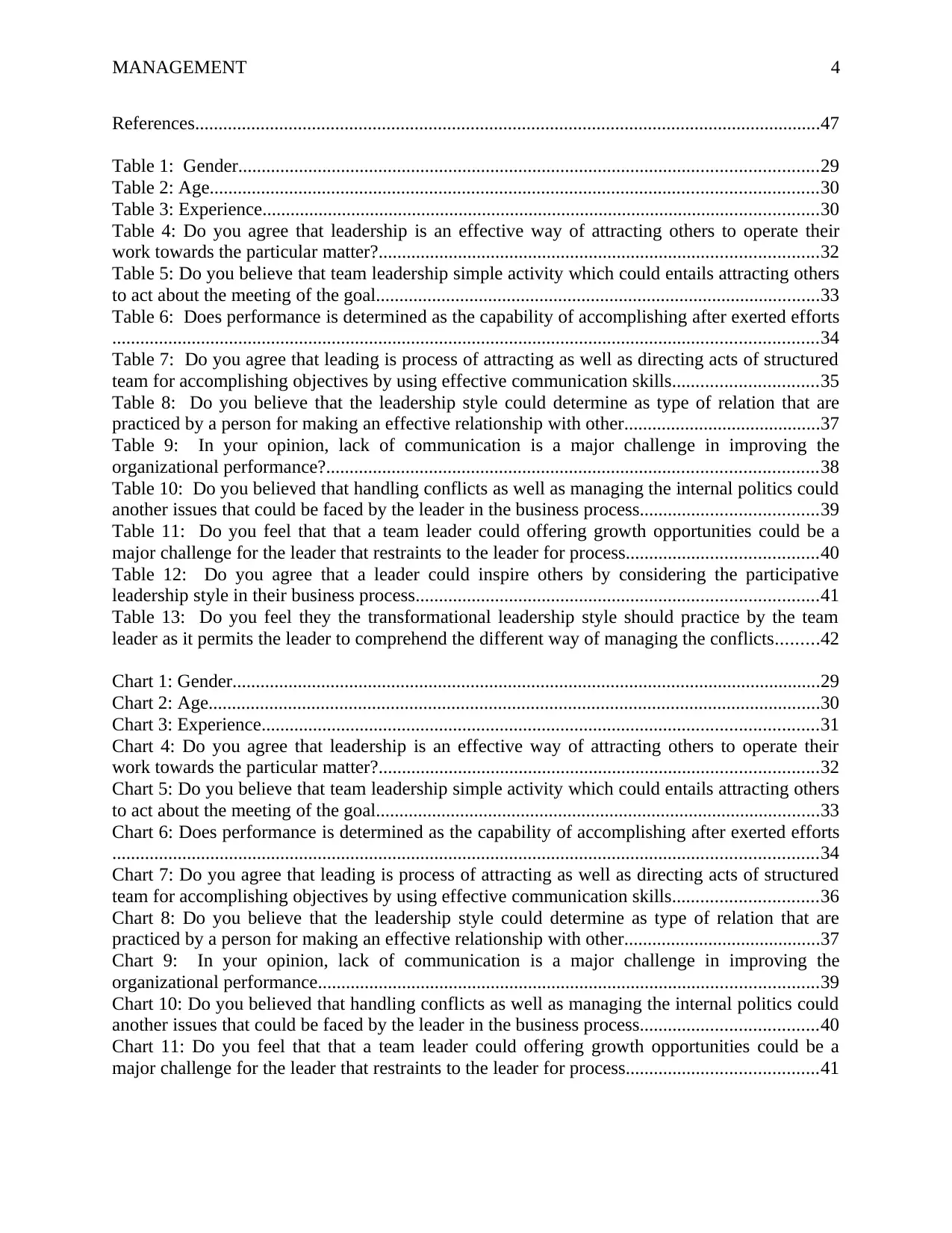
MANAGEMENT 4
References......................................................................................................................................47
Table 1: Gender............................................................................................................................29
Table 2: Age..................................................................................................................................30
Table 3: Experience.......................................................................................................................30
Table 4: Do you agree that leadership is an effective way of attracting others to operate their
work towards the particular matter?..............................................................................................32
Table 5: Do you believe that team leadership simple activity which could entails attracting others
to act about the meeting of the goal...............................................................................................33
Table 6: Does performance is determined as the capability of accomplishing after exerted efforts
.......................................................................................................................................................34
Table 7: Do you agree that leading is process of attracting as well as directing acts of structured
team for accomplishing objectives by using effective communication skills...............................35
Table 8: Do you believe that the leadership style could determine as type of relation that are
practiced by a person for making an effective relationship with other..........................................37
Table 9: In your opinion, lack of communication is a major challenge in improving the
organizational performance?.........................................................................................................38
Table 10: Do you believed that handling conflicts as well as managing the internal politics could
another issues that could be faced by the leader in the business process......................................39
Table 11: Do you feel that that a team leader could offering growth opportunities could be a
major challenge for the leader that restraints to the leader for process.........................................40
Table 12: Do you agree that a leader could inspire others by considering the participative
leadership style in their business process......................................................................................41
Table 13: Do you feel they the transformational leadership style should practice by the team
leader as it permits the leader to comprehend the different way of managing the conflicts.........42
Chart 1: Gender..............................................................................................................................29
Chart 2: Age...................................................................................................................................30
Chart 3: Experience.......................................................................................................................31
Chart 4: Do you agree that leadership is an effective way of attracting others to operate their
work towards the particular matter?..............................................................................................32
Chart 5: Do you believe that team leadership simple activity which could entails attracting others
to act about the meeting of the goal...............................................................................................33
Chart 6: Does performance is determined as the capability of accomplishing after exerted efforts
.......................................................................................................................................................34
Chart 7: Do you agree that leading is process of attracting as well as directing acts of structured
team for accomplishing objectives by using effective communication skills...............................36
Chart 8: Do you believe that the leadership style could determine as type of relation that are
practiced by a person for making an effective relationship with other..........................................37
Chart 9: In your opinion, lack of communication is a major challenge in improving the
organizational performance...........................................................................................................39
Chart 10: Do you believed that handling conflicts as well as managing the internal politics could
another issues that could be faced by the leader in the business process......................................40
Chart 11: Do you feel that that a team leader could offering growth opportunities could be a
major challenge for the leader that restraints to the leader for process.........................................41
References......................................................................................................................................47
Table 1: Gender............................................................................................................................29
Table 2: Age..................................................................................................................................30
Table 3: Experience.......................................................................................................................30
Table 4: Do you agree that leadership is an effective way of attracting others to operate their
work towards the particular matter?..............................................................................................32
Table 5: Do you believe that team leadership simple activity which could entails attracting others
to act about the meeting of the goal...............................................................................................33
Table 6: Does performance is determined as the capability of accomplishing after exerted efforts
.......................................................................................................................................................34
Table 7: Do you agree that leading is process of attracting as well as directing acts of structured
team for accomplishing objectives by using effective communication skills...............................35
Table 8: Do you believe that the leadership style could determine as type of relation that are
practiced by a person for making an effective relationship with other..........................................37
Table 9: In your opinion, lack of communication is a major challenge in improving the
organizational performance?.........................................................................................................38
Table 10: Do you believed that handling conflicts as well as managing the internal politics could
another issues that could be faced by the leader in the business process......................................39
Table 11: Do you feel that that a team leader could offering growth opportunities could be a
major challenge for the leader that restraints to the leader for process.........................................40
Table 12: Do you agree that a leader could inspire others by considering the participative
leadership style in their business process......................................................................................41
Table 13: Do you feel they the transformational leadership style should practice by the team
leader as it permits the leader to comprehend the different way of managing the conflicts.........42
Chart 1: Gender..............................................................................................................................29
Chart 2: Age...................................................................................................................................30
Chart 3: Experience.......................................................................................................................31
Chart 4: Do you agree that leadership is an effective way of attracting others to operate their
work towards the particular matter?..............................................................................................32
Chart 5: Do you believe that team leadership simple activity which could entails attracting others
to act about the meeting of the goal...............................................................................................33
Chart 6: Does performance is determined as the capability of accomplishing after exerted efforts
.......................................................................................................................................................34
Chart 7: Do you agree that leading is process of attracting as well as directing acts of structured
team for accomplishing objectives by using effective communication skills...............................36
Chart 8: Do you believe that the leadership style could determine as type of relation that are
practiced by a person for making an effective relationship with other..........................................37
Chart 9: In your opinion, lack of communication is a major challenge in improving the
organizational performance...........................................................................................................39
Chart 10: Do you believed that handling conflicts as well as managing the internal politics could
another issues that could be faced by the leader in the business process......................................40
Chart 11: Do you feel that that a team leader could offering growth opportunities could be a
major challenge for the leader that restraints to the leader for process.........................................41
Paraphrase This Document
Need a fresh take? Get an instant paraphrase of this document with our AI Paraphraser
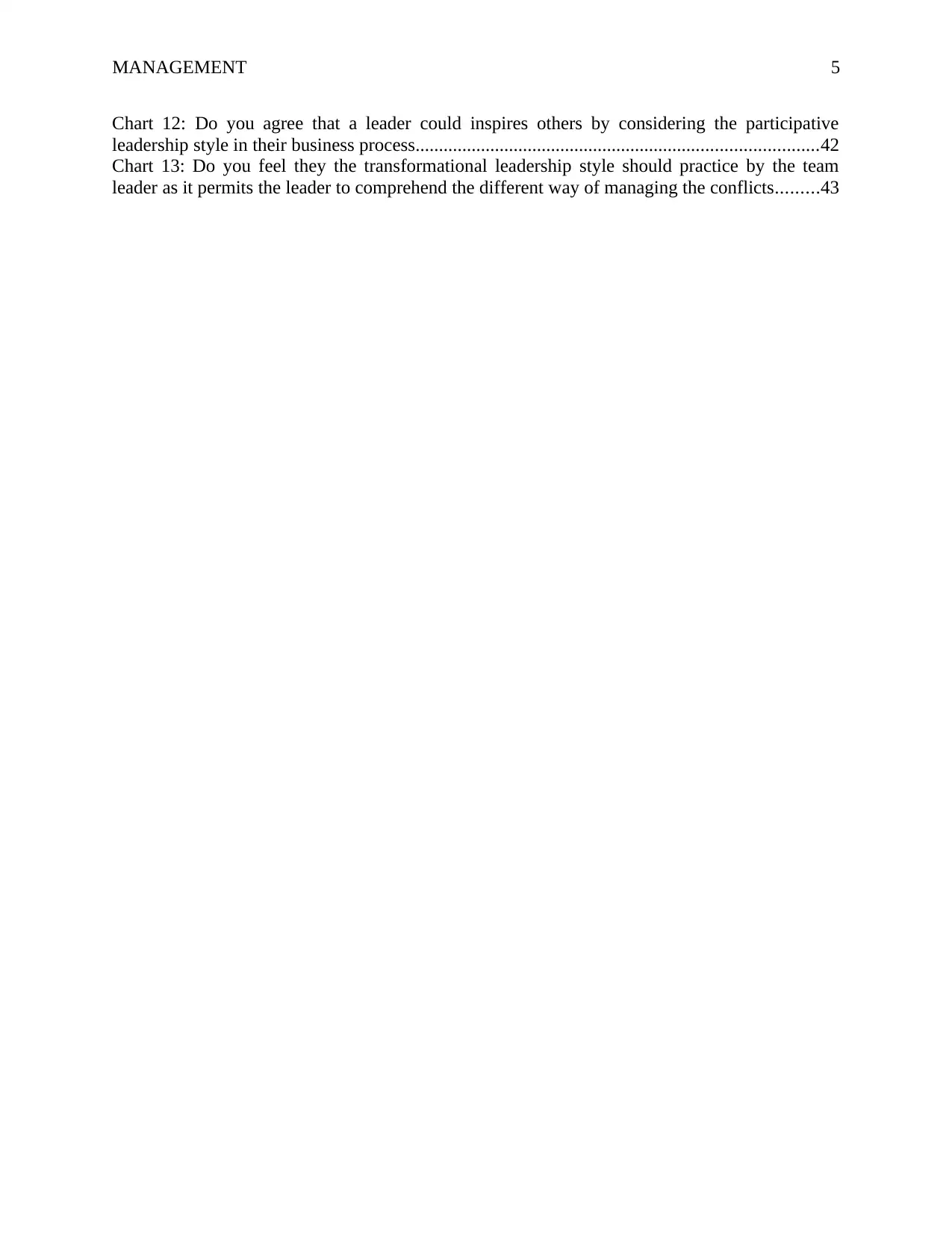
MANAGEMENT 5
Chart 12: Do you agree that a leader could inspires others by considering the participative
leadership style in their business process......................................................................................42
Chart 13: Do you feel they the transformational leadership style should practice by the team
leader as it permits the leader to comprehend the different way of managing the conflicts.........43
Chart 12: Do you agree that a leader could inspires others by considering the participative
leadership style in their business process......................................................................................42
Chart 13: Do you feel they the transformational leadership style should practice by the team
leader as it permits the leader to comprehend the different way of managing the conflicts.........43
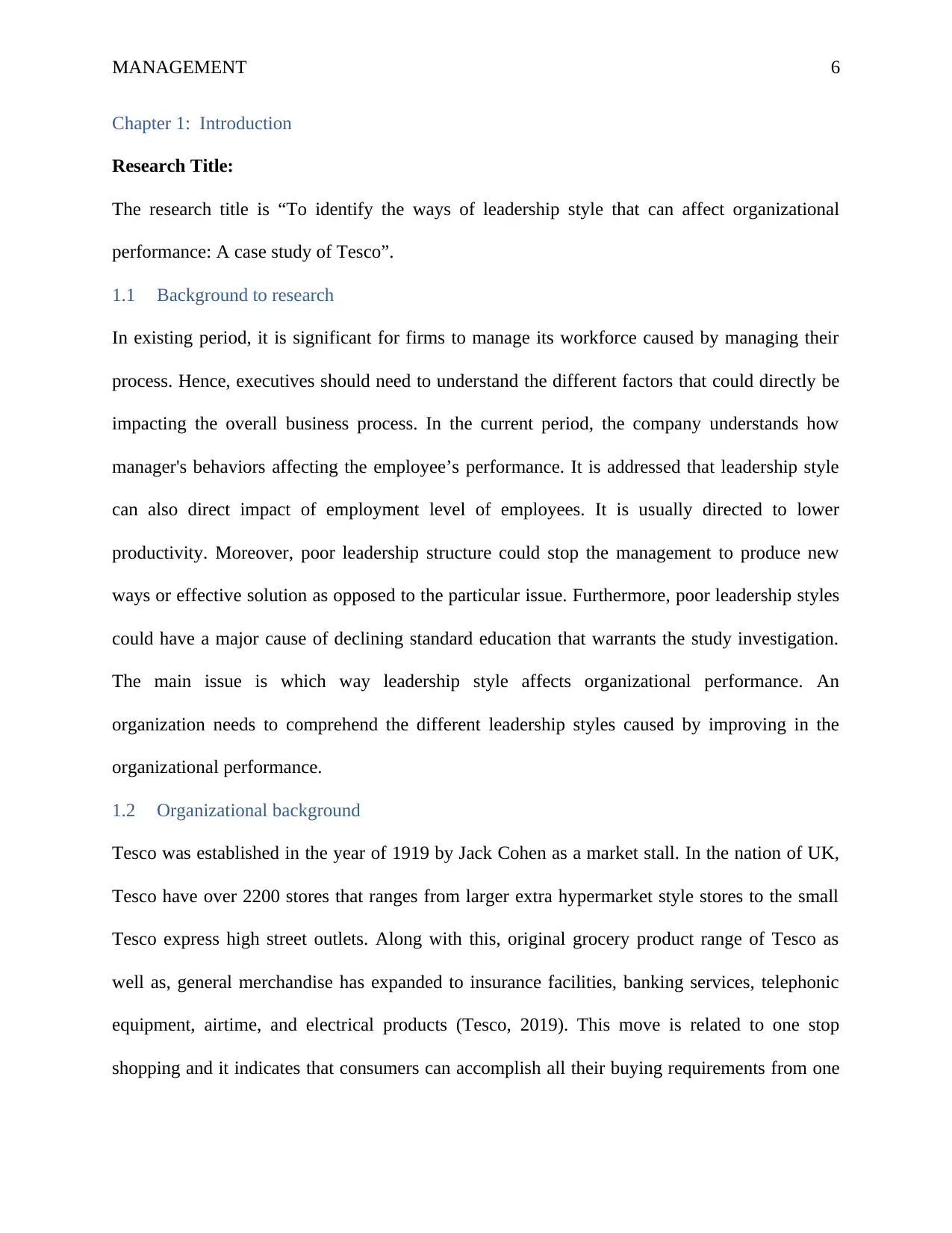
MANAGEMENT 6
Chapter 1: Introduction
Research Title:
The research title is “To identify the ways of leadership style that can affect organizational
performance: A case study of Tesco”.
1.1 Background to research
In existing period, it is significant for firms to manage its workforce caused by managing their
process. Hence, executives should need to understand the different factors that could directly be
impacting the overall business process. In the current period, the company understands how
manager's behaviors affecting the employee’s performance. It is addressed that leadership style
can also direct impact of employment level of employees. It is usually directed to lower
productivity. Moreover, poor leadership structure could stop the management to produce new
ways or effective solution as opposed to the particular issue. Furthermore, poor leadership styles
could have a major cause of declining standard education that warrants the study investigation.
The main issue is which way leadership style affects organizational performance. An
organization needs to comprehend the different leadership styles caused by improving in the
organizational performance.
1.2 Organizational background
Tesco was established in the year of 1919 by Jack Cohen as a market stall. In the nation of UK,
Tesco have over 2200 stores that ranges from larger extra hypermarket style stores to the small
Tesco express high street outlets. Along with this, original grocery product range of Tesco as
well as, general merchandise has expanded to insurance facilities, banking services, telephonic
equipment, airtime, and electrical products (Tesco, 2019). This move is related to one stop
shopping and it indicates that consumers can accomplish all their buying requirements from one
Chapter 1: Introduction
Research Title:
The research title is “To identify the ways of leadership style that can affect organizational
performance: A case study of Tesco”.
1.1 Background to research
In existing period, it is significant for firms to manage its workforce caused by managing their
process. Hence, executives should need to understand the different factors that could directly be
impacting the overall business process. In the current period, the company understands how
manager's behaviors affecting the employee’s performance. It is addressed that leadership style
can also direct impact of employment level of employees. It is usually directed to lower
productivity. Moreover, poor leadership structure could stop the management to produce new
ways or effective solution as opposed to the particular issue. Furthermore, poor leadership styles
could have a major cause of declining standard education that warrants the study investigation.
The main issue is which way leadership style affects organizational performance. An
organization needs to comprehend the different leadership styles caused by improving in the
organizational performance.
1.2 Organizational background
Tesco was established in the year of 1919 by Jack Cohen as a market stall. In the nation of UK,
Tesco have over 2200 stores that ranges from larger extra hypermarket style stores to the small
Tesco express high street outlets. Along with this, original grocery product range of Tesco as
well as, general merchandise has expanded to insurance facilities, banking services, telephonic
equipment, airtime, and electrical products (Tesco, 2019). This move is related to one stop
shopping and it indicates that consumers can accomplish all their buying requirements from one
⊘ This is a preview!⊘
Do you want full access?
Subscribe today to unlock all pages.

Trusted by 1+ million students worldwide
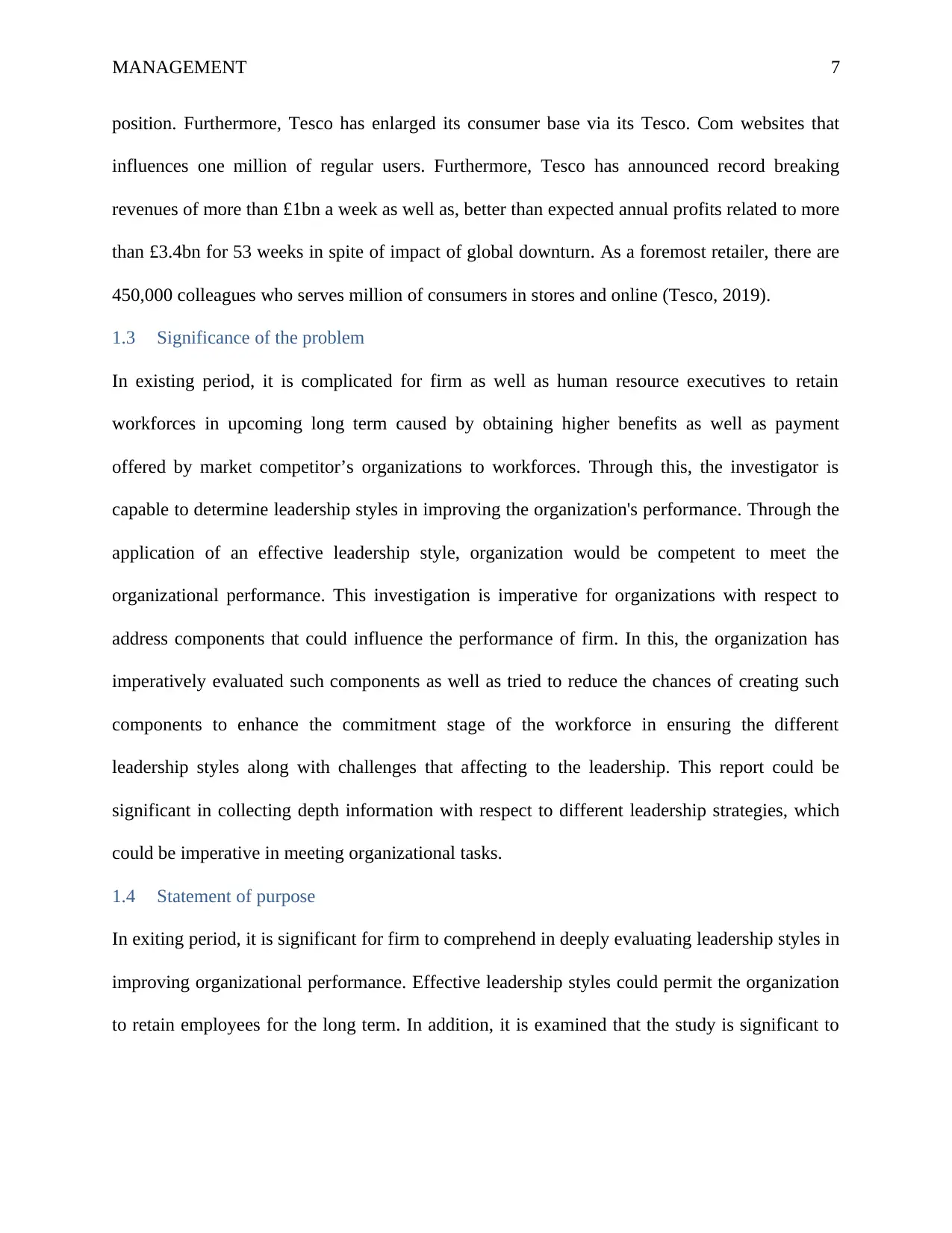
MANAGEMENT 7
position. Furthermore, Tesco has enlarged its consumer base via its Tesco. Com websites that
influences one million of regular users. Furthermore, Tesco has announced record breaking
revenues of more than £1bn a week as well as, better than expected annual profits related to more
than £3.4bn for 53 weeks in spite of impact of global downturn. As a foremost retailer, there are
450,000 colleagues who serves million of consumers in stores and online (Tesco, 2019).
1.3 Significance of the problem
In existing period, it is complicated for firm as well as human resource executives to retain
workforces in upcoming long term caused by obtaining higher benefits as well as payment
offered by market competitor’s organizations to workforces. Through this, the investigator is
capable to determine leadership styles in improving the organization's performance. Through the
application of an effective leadership style, organization would be competent to meet the
organizational performance. This investigation is imperative for organizations with respect to
address components that could influence the performance of firm. In this, the organization has
imperatively evaluated such components as well as tried to reduce the chances of creating such
components to enhance the commitment stage of the workforce in ensuring the different
leadership styles along with challenges that affecting to the leadership. This report could be
significant in collecting depth information with respect to different leadership strategies, which
could be imperative in meeting organizational tasks.
1.4 Statement of purpose
In exiting period, it is significant for firm to comprehend in deeply evaluating leadership styles in
improving organizational performance. Effective leadership styles could permit the organization
to retain employees for the long term. In addition, it is examined that the study is significant to
position. Furthermore, Tesco has enlarged its consumer base via its Tesco. Com websites that
influences one million of regular users. Furthermore, Tesco has announced record breaking
revenues of more than £1bn a week as well as, better than expected annual profits related to more
than £3.4bn for 53 weeks in spite of impact of global downturn. As a foremost retailer, there are
450,000 colleagues who serves million of consumers in stores and online (Tesco, 2019).
1.3 Significance of the problem
In existing period, it is complicated for firm as well as human resource executives to retain
workforces in upcoming long term caused by obtaining higher benefits as well as payment
offered by market competitor’s organizations to workforces. Through this, the investigator is
capable to determine leadership styles in improving the organization's performance. Through the
application of an effective leadership style, organization would be competent to meet the
organizational performance. This investigation is imperative for organizations with respect to
address components that could influence the performance of firm. In this, the organization has
imperatively evaluated such components as well as tried to reduce the chances of creating such
components to enhance the commitment stage of the workforce in ensuring the different
leadership styles along with challenges that affecting to the leadership. This report could be
significant in collecting depth information with respect to different leadership strategies, which
could be imperative in meeting organizational tasks.
1.4 Statement of purpose
In exiting period, it is significant for firm to comprehend in deeply evaluating leadership styles in
improving organizational performance. Effective leadership styles could permit the organization
to retain employees for the long term. In addition, it is examined that the study is significant to
Paraphrase This Document
Need a fresh take? Get an instant paraphrase of this document with our AI Paraphraser
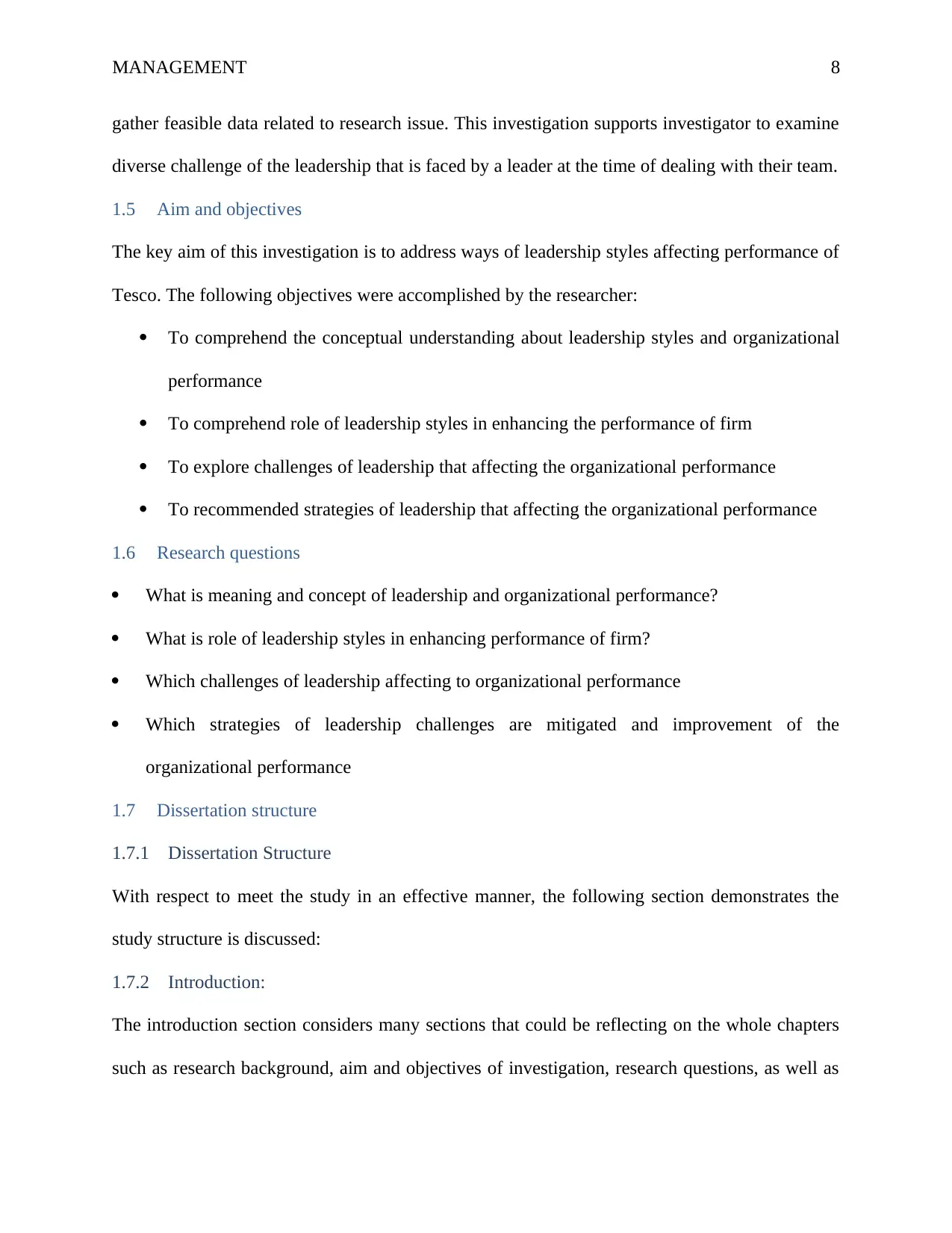
MANAGEMENT 8
gather feasible data related to research issue. This investigation supports investigator to examine
diverse challenge of the leadership that is faced by a leader at the time of dealing with their team.
1.5 Aim and objectives
The key aim of this investigation is to address ways of leadership styles affecting performance of
Tesco. The following objectives were accomplished by the researcher:
To comprehend the conceptual understanding about leadership styles and organizational
performance
To comprehend role of leadership styles in enhancing the performance of firm
To explore challenges of leadership that affecting the organizational performance
To recommended strategies of leadership that affecting the organizational performance
1.6 Research questions
What is meaning and concept of leadership and organizational performance?
What is role of leadership styles in enhancing performance of firm?
Which challenges of leadership affecting to organizational performance
Which strategies of leadership challenges are mitigated and improvement of the
organizational performance
1.7 Dissertation structure
1.7.1 Dissertation Structure
With respect to meet the study in an effective manner, the following section demonstrates the
study structure is discussed:
1.7.2 Introduction:
The introduction section considers many sections that could be reflecting on the whole chapters
such as research background, aim and objectives of investigation, research questions, as well as
gather feasible data related to research issue. This investigation supports investigator to examine
diverse challenge of the leadership that is faced by a leader at the time of dealing with their team.
1.5 Aim and objectives
The key aim of this investigation is to address ways of leadership styles affecting performance of
Tesco. The following objectives were accomplished by the researcher:
To comprehend the conceptual understanding about leadership styles and organizational
performance
To comprehend role of leadership styles in enhancing the performance of firm
To explore challenges of leadership that affecting the organizational performance
To recommended strategies of leadership that affecting the organizational performance
1.6 Research questions
What is meaning and concept of leadership and organizational performance?
What is role of leadership styles in enhancing performance of firm?
Which challenges of leadership affecting to organizational performance
Which strategies of leadership challenges are mitigated and improvement of the
organizational performance
1.7 Dissertation structure
1.7.1 Dissertation Structure
With respect to meet the study in an effective manner, the following section demonstrates the
study structure is discussed:
1.7.2 Introduction:
The introduction section considers many sections that could be reflecting on the whole chapters
such as research background, aim and objectives of investigation, research questions, as well as
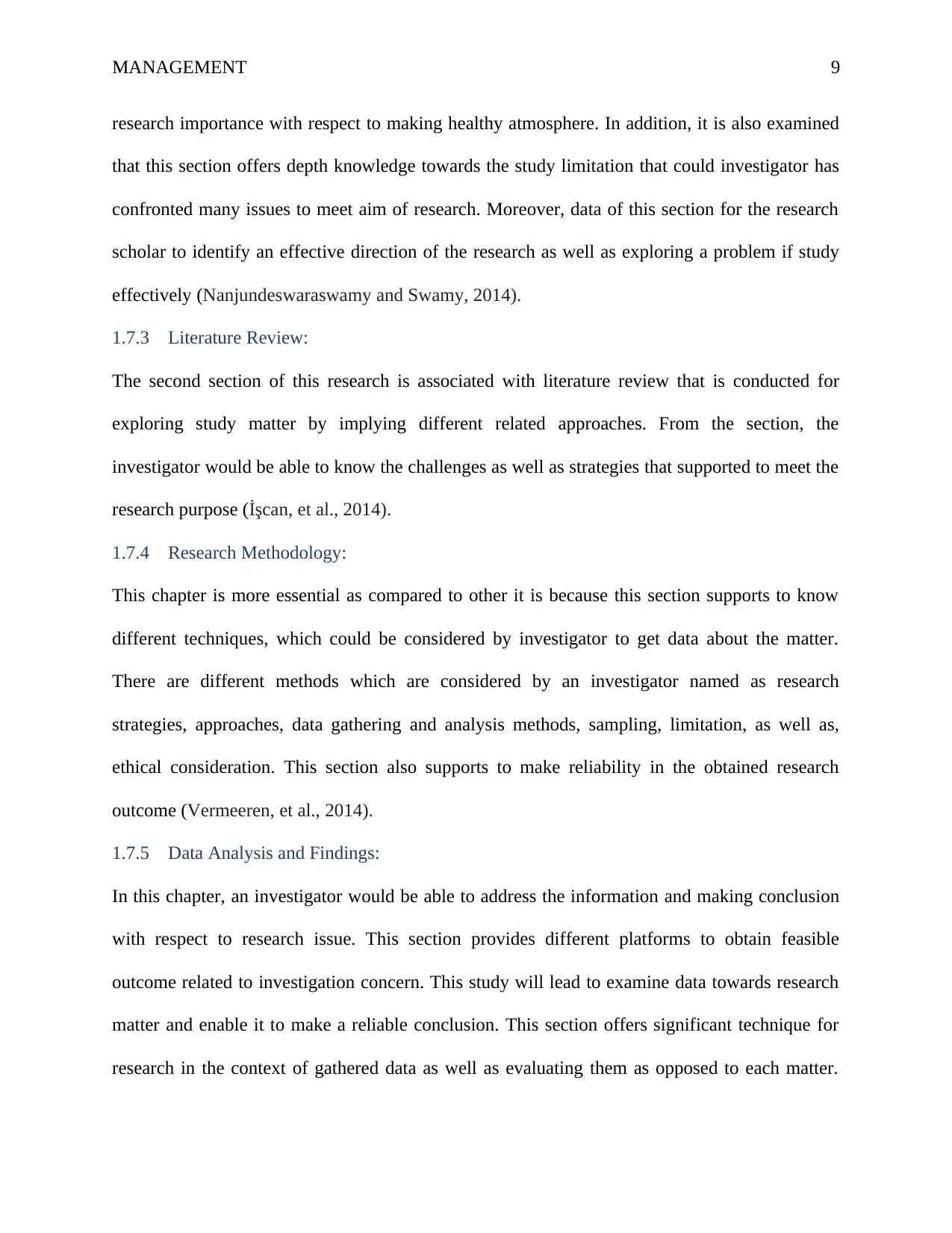
MANAGEMENT 9
research importance with respect to making healthy atmosphere. In addition, it is also examined
that this section offers depth knowledge towards the study limitation that could investigator has
confronted many issues to meet aim of research. Moreover, data of this section for the research
scholar to identify an effective direction of the research as well as exploring a problem if study
effectively (Nanjundeswaraswamy and Swamy, 2014).
1.7.3 Literature Review:
The second section of this research is associated with literature review that is conducted for
exploring study matter by implying different related approaches. From the section, the
investigator would be able to know the challenges as well as strategies that supported to meet the
research purpose (İşcan, et al., 2014).
1.7.4 Research Methodology:
This chapter is more essential as compared to other it is because this section supports to know
different techniques, which could be considered by investigator to get data about the matter.
There are different methods which are considered by an investigator named as research
strategies, approaches, data gathering and analysis methods, sampling, limitation, as well as,
ethical consideration. This section also supports to make reliability in the obtained research
outcome (Vermeeren, et al., 2014).
1.7.5 Data Analysis and Findings:
In this chapter, an investigator would be able to address the information and making conclusion
with respect to research issue. This section provides different platforms to obtain feasible
outcome related to investigation concern. This study will lead to examine data towards research
matter and enable it to make a reliable conclusion. This section offers significant technique for
research in the context of gathered data as well as evaluating them as opposed to each matter.
research importance with respect to making healthy atmosphere. In addition, it is also examined
that this section offers depth knowledge towards the study limitation that could investigator has
confronted many issues to meet aim of research. Moreover, data of this section for the research
scholar to identify an effective direction of the research as well as exploring a problem if study
effectively (Nanjundeswaraswamy and Swamy, 2014).
1.7.3 Literature Review:
The second section of this research is associated with literature review that is conducted for
exploring study matter by implying different related approaches. From the section, the
investigator would be able to know the challenges as well as strategies that supported to meet the
research purpose (İşcan, et al., 2014).
1.7.4 Research Methodology:
This chapter is more essential as compared to other it is because this section supports to know
different techniques, which could be considered by investigator to get data about the matter.
There are different methods which are considered by an investigator named as research
strategies, approaches, data gathering and analysis methods, sampling, limitation, as well as,
ethical consideration. This section also supports to make reliability in the obtained research
outcome (Vermeeren, et al., 2014).
1.7.5 Data Analysis and Findings:
In this chapter, an investigator would be able to address the information and making conclusion
with respect to research issue. This section provides different platforms to obtain feasible
outcome related to investigation concern. This study will lead to examine data towards research
matter and enable it to make a reliable conclusion. This section offers significant technique for
research in the context of gathered data as well as evaluating them as opposed to each matter.
⊘ This is a preview!⊘
Do you want full access?
Subscribe today to unlock all pages.

Trusted by 1+ million students worldwide
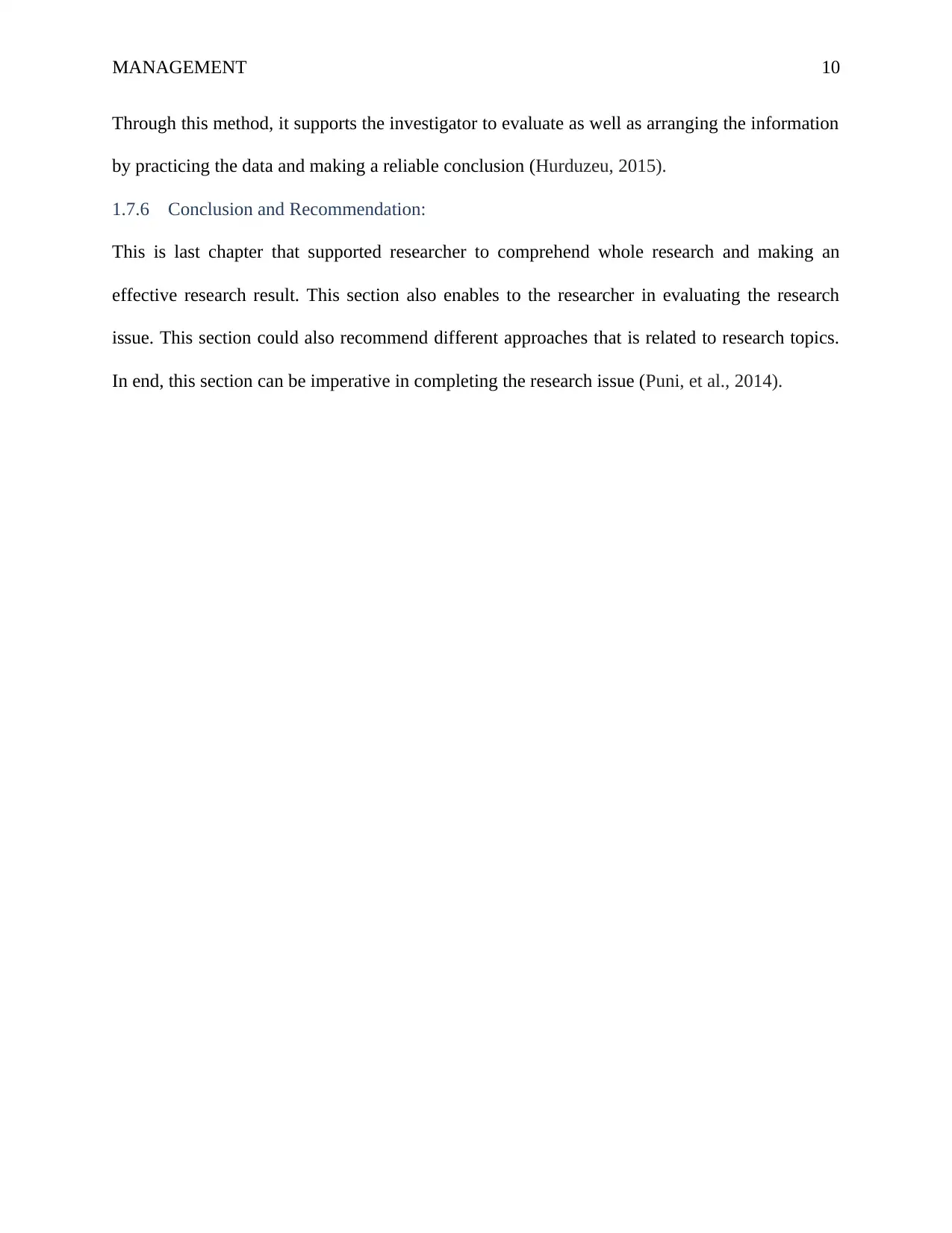
MANAGEMENT 10
Through this method, it supports the investigator to evaluate as well as arranging the information
by practicing the data and making a reliable conclusion (Hurduzeu, 2015).
1.7.6 Conclusion and Recommendation:
This is last chapter that supported researcher to comprehend whole research and making an
effective research result. This section also enables to the researcher in evaluating the research
issue. This section could also recommend different approaches that is related to research topics.
In end, this section can be imperative in completing the research issue (Puni, et al., 2014).
Through this method, it supports the investigator to evaluate as well as arranging the information
by practicing the data and making a reliable conclusion (Hurduzeu, 2015).
1.7.6 Conclusion and Recommendation:
This is last chapter that supported researcher to comprehend whole research and making an
effective research result. This section also enables to the researcher in evaluating the research
issue. This section could also recommend different approaches that is related to research topics.
In end, this section can be imperative in completing the research issue (Puni, et al., 2014).
Paraphrase This Document
Need a fresh take? Get an instant paraphrase of this document with our AI Paraphraser
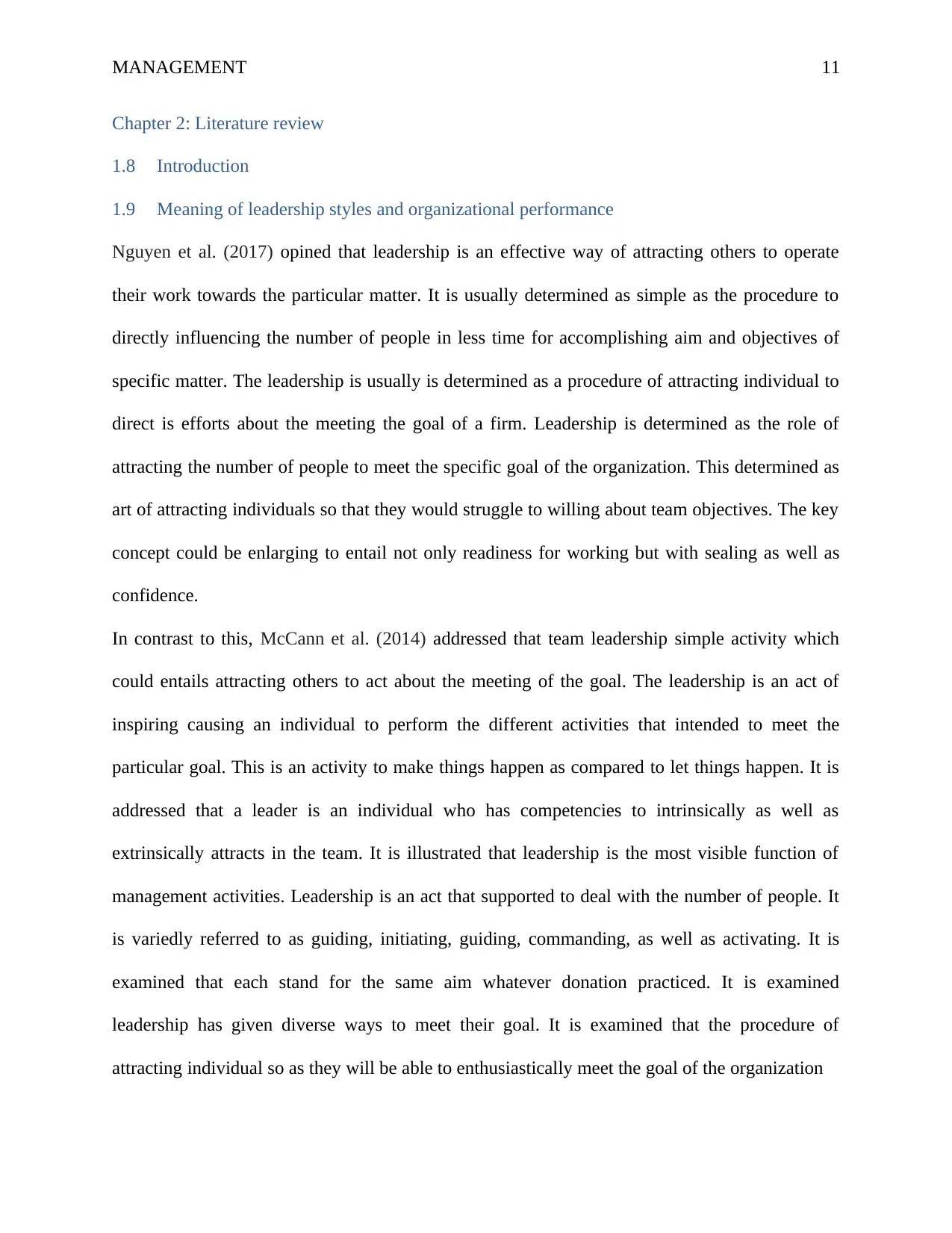
MANAGEMENT 11
Chapter 2: Literature review
1.8 Introduction
1.9 Meaning of leadership styles and organizational performance
Nguyen et al. (2017) opined that leadership is an effective way of attracting others to operate
their work towards the particular matter. It is usually determined as simple as the procedure to
directly influencing the number of people in less time for accomplishing aim and objectives of
specific matter. The leadership is usually is determined as a procedure of attracting individual to
direct is efforts about the meeting the goal of a firm. Leadership is determined as the role of
attracting the number of people to meet the specific goal of the organization. This determined as
art of attracting individuals so that they would struggle to willing about team objectives. The key
concept could be enlarging to entail not only readiness for working but with sealing as well as
confidence.
In contrast to this, McCann et al. (2014) addressed that team leadership simple activity which
could entails attracting others to act about the meeting of the goal. The leadership is an act of
inspiring causing an individual to perform the different activities that intended to meet the
particular goal. This is an activity to make things happen as compared to let things happen. It is
addressed that a leader is an individual who has competencies to intrinsically as well as
extrinsically attracts in the team. It is illustrated that leadership is the most visible function of
management activities. Leadership is an act that supported to deal with the number of people. It
is variedly referred to as guiding, initiating, guiding, commanding, as well as activating. It is
examined that each stand for the same aim whatever donation practiced. It is examined
leadership has given diverse ways to meet their goal. It is examined that the procedure of
attracting individual so as they will be able to enthusiastically meet the goal of the organization
Chapter 2: Literature review
1.8 Introduction
1.9 Meaning of leadership styles and organizational performance
Nguyen et al. (2017) opined that leadership is an effective way of attracting others to operate
their work towards the particular matter. It is usually determined as simple as the procedure to
directly influencing the number of people in less time for accomplishing aim and objectives of
specific matter. The leadership is usually is determined as a procedure of attracting individual to
direct is efforts about the meeting the goal of a firm. Leadership is determined as the role of
attracting the number of people to meet the specific goal of the organization. This determined as
art of attracting individuals so that they would struggle to willing about team objectives. The key
concept could be enlarging to entail not only readiness for working but with sealing as well as
confidence.
In contrast to this, McCann et al. (2014) addressed that team leadership simple activity which
could entails attracting others to act about the meeting of the goal. The leadership is an act of
inspiring causing an individual to perform the different activities that intended to meet the
particular goal. This is an activity to make things happen as compared to let things happen. It is
addressed that a leader is an individual who has competencies to intrinsically as well as
extrinsically attracts in the team. It is illustrated that leadership is the most visible function of
management activities. Leadership is an act that supported to deal with the number of people. It
is variedly referred to as guiding, initiating, guiding, commanding, as well as activating. It is
examined that each stand for the same aim whatever donation practiced. It is examined
leadership has given diverse ways to meet their goal. It is examined that the procedure of
attracting individual so as they will be able to enthusiastically meet the goal of the organization
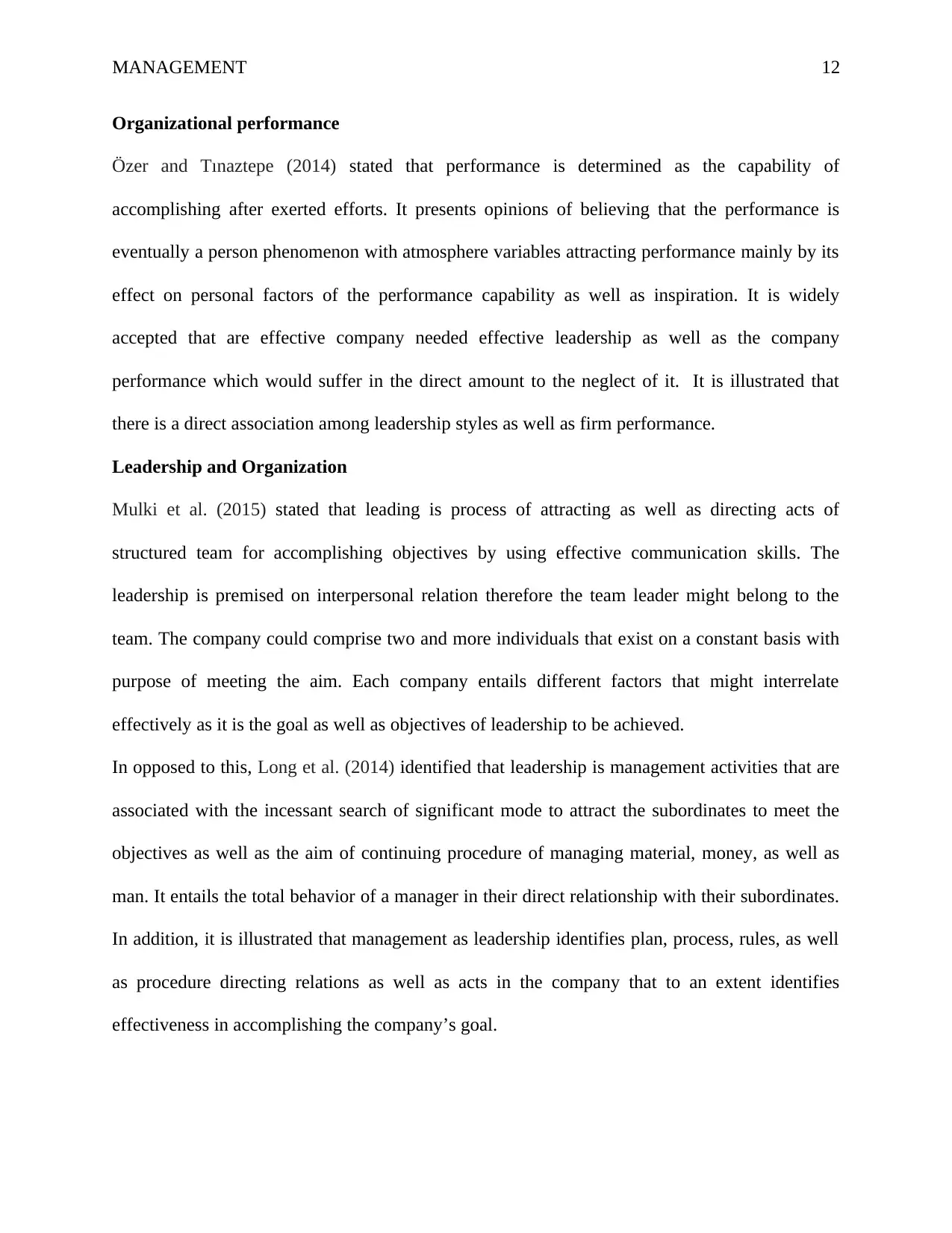
MANAGEMENT 12
Organizational performance
Özer and Tınaztepe (2014) stated that performance is determined as the capability of
accomplishing after exerted efforts. It presents opinions of believing that the performance is
eventually a person phenomenon with atmosphere variables attracting performance mainly by its
effect on personal factors of the performance capability as well as inspiration. It is widely
accepted that are effective company needed effective leadership as well as the company
performance which would suffer in the direct amount to the neglect of it. It is illustrated that
there is a direct association among leadership styles as well as firm performance.
Leadership and Organization
Mulki et al. (2015) stated that leading is process of attracting as well as directing acts of
structured team for accomplishing objectives by using effective communication skills. The
leadership is premised on interpersonal relation therefore the team leader might belong to the
team. The company could comprise two and more individuals that exist on a constant basis with
purpose of meeting the aim. Each company entails different factors that might interrelate
effectively as it is the goal as well as objectives of leadership to be achieved.
In opposed to this, Long et al. (2014) identified that leadership is management activities that are
associated with the incessant search of significant mode to attract the subordinates to meet the
objectives as well as the aim of continuing procedure of managing material, money, as well as
man. It entails the total behavior of a manager in their direct relationship with their subordinates.
In addition, it is illustrated that management as leadership identifies plan, process, rules, as well
as procedure directing relations as well as acts in the company that to an extent identifies
effectiveness in accomplishing the company’s goal.
Organizational performance
Özer and Tınaztepe (2014) stated that performance is determined as the capability of
accomplishing after exerted efforts. It presents opinions of believing that the performance is
eventually a person phenomenon with atmosphere variables attracting performance mainly by its
effect on personal factors of the performance capability as well as inspiration. It is widely
accepted that are effective company needed effective leadership as well as the company
performance which would suffer in the direct amount to the neglect of it. It is illustrated that
there is a direct association among leadership styles as well as firm performance.
Leadership and Organization
Mulki et al. (2015) stated that leading is process of attracting as well as directing acts of
structured team for accomplishing objectives by using effective communication skills. The
leadership is premised on interpersonal relation therefore the team leader might belong to the
team. The company could comprise two and more individuals that exist on a constant basis with
purpose of meeting the aim. Each company entails different factors that might interrelate
effectively as it is the goal as well as objectives of leadership to be achieved.
In opposed to this, Long et al. (2014) identified that leadership is management activities that are
associated with the incessant search of significant mode to attract the subordinates to meet the
objectives as well as the aim of continuing procedure of managing material, money, as well as
man. It entails the total behavior of a manager in their direct relationship with their subordinates.
In addition, it is illustrated that management as leadership identifies plan, process, rules, as well
as procedure directing relations as well as acts in the company that to an extent identifies
effectiveness in accomplishing the company’s goal.
⊘ This is a preview!⊘
Do you want full access?
Subscribe today to unlock all pages.

Trusted by 1+ million students worldwide
1 out of 57
Related Documents
Your All-in-One AI-Powered Toolkit for Academic Success.
+13062052269
info@desklib.com
Available 24*7 on WhatsApp / Email
![[object Object]](/_next/static/media/star-bottom.7253800d.svg)
Unlock your academic potential
Copyright © 2020–2025 A2Z Services. All Rights Reserved. Developed and managed by ZUCOL.





